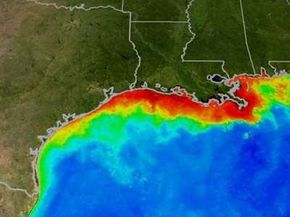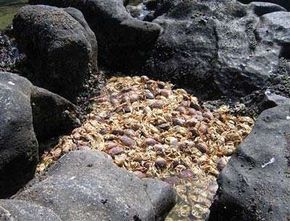Every spring, a vast area of the northern Gulf of Mexico loses most of itsoxygenand becomes deadly to marine life. The "dead zone," also called ahypoxic zone, is caused by the growth of massive quantities of algae known asalgal blooms. As algae die, bacteria feed on them and, in the process, suck up the water's available oxygen. Oxygen levels become depleted to the point that the area cannot support marine life, and sea creatures must swim to other waters or die. Beside being inhospitable to most sea life, algal blooms also cause dead zone waters to turn brown.
Ocean Conservation Image Gallery
Advertisement
What causes the algal blooms? In part, it's a natural phenomenon, but they've been significantly boosted byfertilizer,sewageand other pollutants entering the Gulf of Mexico from the Mississippi and Atchafalaya Rivers, both of which are fed by bodies of water from around the country. These pollutants contain phosphorus and nitrogen, which are excellent food for algae. When springtime comes and the snows melt, increased water levels bring more nutrients for the algae, which also thrive in warm water. The dead zone peaks around early August and then recedes in the fall, when nitrogen levels in water diminish.
The 2007 dead zone is one of the largest since measurements began in 1985. It was mapped at around 7,900 square miles -- bigger than several U.S. states [Source: CNN]. The 2006 dead zone was 6,662 square miles [Source:BBC], while the one in 2002, the largest on record so far, measured 8,495 square miles [Source:Reuters].
In 2007, the level of algae-boosting nutrients entering the Gulf of Mexico represented a 300 percent increase over levels of a half century before, when dead zones were an infrequent occurrence [Source:BBC].A scientist from Louisiana State University attributed the change to an increase in intensive farming, which generally employs lots of nitrogen-rich fertilizers, combined with effects from the weather [Source:BBC].
The National Oceanic and Atmospheric Administration (NOAA), which monitors the dead zone, said the area presents a danger to the $2.8 billion-per-year fishing industry that operates along the Texas and Louisiana coasts [Source:NOAA].数百万英镑的棕色虾被every year in these waters, but over the last decade, fishermen have reported declining brown shrimp catches. Shrimp may be dying or simply swimming to other, more breathable waters.
The Gulf of Mexico dead zone isn't the world's only hypoxic zone. For years, Lake Erie has suffered from a recurring dead zone, believed to be a result of a combination of phosphorus contamination, invasive mussel species and a warming climate. A report from the United Nations in 2003 said that the number of seasonal dead zones around the world had doubled every 10 years since the 1960s [Source:BBC].A NOAA report cites low oxygen levels as a major problem in shallow waterways and coastal areas worldwide.
There are other problems for fishing communities, too. Harmful algal blooms (HABs), like red tide and golden algae, produce toxins when they decay, killing marine life and making the creatures poisonous to humans. But HABs shouldn't be confused with the algal blooms described above. While human pollution contributes to the Gulf of Mexico's dead zone and other hypoxic zones, scientists have yet to establish a connection between pollution and HABs, which occur naturally.
On the next page, we'll take a closer look at the causes of the dead zone and what's being done to prevent it from growing even larger.
Advertisement




